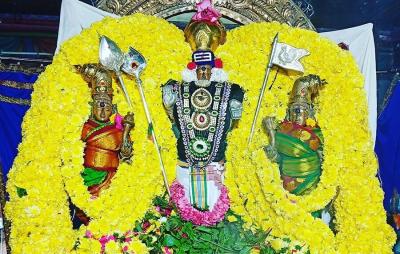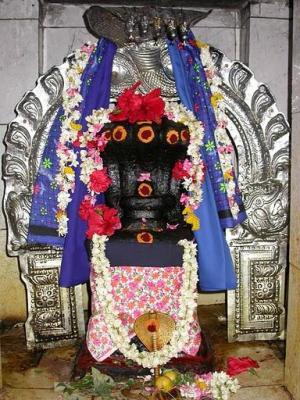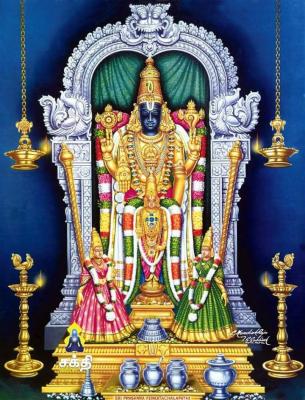A swayambu Lingam with perennial Stream flowing - Neer sthalam
Jambukeswarar Temple - also known as Thiruvanaika and Jambukeswaram - is a famous Shiva temple in Tiruchirapalli district. This temple is also famous for the worship of Goddess Akilandeshwari Amman. It is believed that Godess Parvati during her penance here to marry Lord Shiva, established this Shiva Lingam. Thiruvanaika is one of the Pancha Bhootha Stalam (Five great natural elements) representing water. There is a freshwater spring underneath the sanctum of Jambukeswara, which has a perennial flow.

Legend says that, there were two Siva Ganas (Siva's disciples who live in Kailash) 'Malyavan' and 'Pushpadanta'. They always quarrel with each other and fight for the rank among Siva Ganas. In one fight 'Malyavan' cursed 'Pushpadanta' to become an elephant on earth and the 'Pushpadanta' cursed the 'Malyavan' to become a spider on earth. The elephant and the spider came to this place and continued their Siva worship. The elephant collected water from river Cauvery and conducted abishegam to the lingam under the Jambu tree (Naaval in tamil) daily. The spider constructed his web over the lingam to prevent dry leaves from dropping on it and prevent sunlight directly falling on it. When the elephant saw the web and thought it was dust on lingam. The elephant tore them and cleaned the lingam by pouring water and the practice continued daily. The spider became angry one day and crawled into the trunk of the elephant and bit the elephant to death, killing itself. Siva, in the form of Jambukeswara, moved by the deep devotion of the two, relieved them from the curse. As an elephant worshipped Siva here, this place came to be known as Thiru Aanai Kaa (thiru means holy, aanai is elephant, kaa means forest). Later the name 'Thiruaanaikaa' become 'Thiruvanaikaval' and 'Thiruvanaikoil'.

As killing the elephant is a sin, the spider was born as the King Kochengat Chola (red-eyed king) in the next birth and built 70 temples. Thiruvanaikaval is one among them. Remembering his enmity with the elephant in his previous birth, Kochengat Chola built all these 70 temples as Mada Koil (Temple with steps) and built sanctums with small entrances as if no elephant can enter. The entrance on the sanctum of Jambukeswara is only 4 foot high and 2.5 foot wide.
The main sannidhi of Jambukeshwarar is situated below ground level and you have to descend three steps from the sannidi entrance. Lord Jambugeshwarar can be viewed only through a stone window that has nine openings, which represents the nine outlets of human body. Entrance into the sannidhi is through a small door about 4 feet in height. Devotees are admitted in groups of five to six into the sannidhi. The lingam of Jambukeswarar is said to be Swayambu. The height of the lingam is about 3 feet from the floor of the sanctum. A water spring emerges from the lingam, which we can see by the wetness of the vastrams adorning the Shiva Lingam. The water flow increases significantly during the rainy season. The only source of illumination within the sannidhi are the ghee lamps, which gives the devotees a divine glow of the Shiva Lingam.
The sannadhi of the Akilandeshwari and the sannadhi of Prasanna Vinayaka are in the shape of the pranava manthra symbol "Om". Like in Kanchipuram, Saint Adi Shankara pacified the anger of the Goddess here too. But instead of establishing Sri Chakra, he installed a pair of Sri Chakra thadangas (ear rings with the power of Sri Chakra) to pacify angry Goddess Akilandeswari. To ensure that she remains in a Sowmya Shantha Swaroopam (merciful form), Adi Shankara installed shrines of her sons Ganesha and Murugan in front of her, as a mother she cannot afford to be angry towards her kids.

As Akilandeswari worshipped Lord Shiva in this temple, even today at noon the Archakar (temple priest) dresses in a female attire and does Pooja to Jambukeswarar and a Gho pooja to black colored cow. This uchi kaala pooja is very famous and a lot of devotees come to worship during this time every day. Annabhishekam to lingam (covering the lingam with cooked rice) is a daily ritual performed in the temple.









Leave a Comment